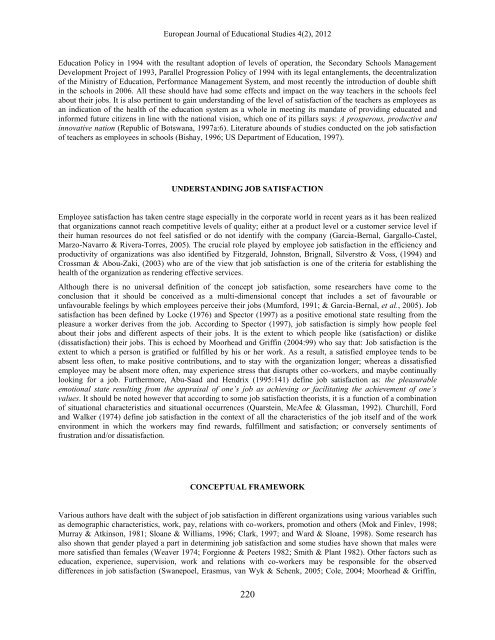the level of the job satisfaction of teachers in botswana pedzani ...
the level of the job satisfaction of teachers in botswana pedzani ...
the level of the job satisfaction of teachers in botswana pedzani ...
You also want an ePaper? Increase the reach of your titles
YUMPU automatically turns print PDFs into web optimized ePapers that Google loves.
European Journal <strong>of</strong> Educational Studies 4(2), 2012<br />
Education Policy <strong>in</strong> 1994 with <strong>the</strong> resultant adoption <strong>of</strong> <strong>level</strong>s <strong>of</strong> operation, <strong>the</strong> Secondary Schools Management<br />
Development Project <strong>of</strong> 1993, Parallel Progression Policy <strong>of</strong> 1994 with its legal entanglements, <strong>the</strong> decentralization<br />
<strong>of</strong> <strong>the</strong> M<strong>in</strong>istry <strong>of</strong> Education, Performance Management System, and most recently <strong>the</strong> <strong>in</strong>troduction <strong>of</strong> double shift<br />
<strong>in</strong> <strong>the</strong> schools <strong>in</strong> 2006. All <strong>the</strong>se should have had some effects and impact on <strong>the</strong> way <strong>teachers</strong> <strong>in</strong> <strong>the</strong> schools feel<br />
about <strong>the</strong>ir <strong>job</strong>s. It is also pert<strong>in</strong>ent to ga<strong>in</strong> understand<strong>in</strong>g <strong>of</strong> <strong>the</strong> <strong>level</strong> <strong>of</strong> <strong>satisfaction</strong> <strong>of</strong> <strong>the</strong> <strong>teachers</strong> as employees as<br />
an <strong>in</strong>dication <strong>of</strong> <strong>the</strong> health <strong>of</strong> <strong>the</strong> education system as a whole <strong>in</strong> meet<strong>in</strong>g its mandate <strong>of</strong> provid<strong>in</strong>g educated and<br />
<strong>in</strong>formed future citizens <strong>in</strong> l<strong>in</strong>e with <strong>the</strong> national vision, which one <strong>of</strong> its pillars says: A prosperous, productive and<br />
<strong>in</strong>novative nation (Republic <strong>of</strong> Botswana, 1997a:6). Literature abounds <strong>of</strong> studies conducted on <strong>the</strong> <strong>job</strong> <strong>satisfaction</strong><br />
<strong>of</strong> <strong>teachers</strong> as employees <strong>in</strong> schools (Bishay, 1996; US Department <strong>of</strong> Education, 1997).<br />
UNDERSTANDING JOB SATISFACTION<br />
Employee <strong>satisfaction</strong> has taken centre stage especially <strong>in</strong> <strong>the</strong> corporate world <strong>in</strong> recent years as it has been realized<br />
that organizations cannot reach competitive <strong>level</strong>s <strong>of</strong> quality; ei<strong>the</strong>r at a product <strong>level</strong> or a customer service <strong>level</strong> if<br />
<strong>the</strong>ir human resources do not feel satisfied or do not identify with <strong>the</strong> company (Garcia-Bernal, Gargallo-Castel,<br />
Marzo-Navarro & Rivera-Torres, 2005). The crucial role played by employee <strong>job</strong> <strong>satisfaction</strong> <strong>in</strong> <strong>the</strong> efficiency and<br />
productivity <strong>of</strong> organizations was also identified by Fitzgerald, Johnston, Brignall, Silverstro & Voss, (1994) and<br />
Crossman & Abou-Zaki, (2003) who are <strong>of</strong> <strong>the</strong> view that <strong>job</strong> <strong>satisfaction</strong> is one <strong>of</strong> <strong>the</strong> criteria for establish<strong>in</strong>g <strong>the</strong><br />
health <strong>of</strong> <strong>the</strong> organization as render<strong>in</strong>g effective services.<br />
Although <strong>the</strong>re is no universal def<strong>in</strong>ition <strong>of</strong> <strong>the</strong> concept <strong>job</strong> <strong>satisfaction</strong>, some researchers have come to <strong>the</strong><br />
conclusion that it should be conceived as a multi-dimensional concept that <strong>in</strong>cludes a set <strong>of</strong> favourable or<br />
unfavourable feel<strong>in</strong>gs by which employees perceive <strong>the</strong>ir <strong>job</strong>s (Mumford, 1991; & Garcia-Bernal, et al., 2005). Job<br />
<strong>satisfaction</strong> has been def<strong>in</strong>ed by Locke (1976) and Spector (1997) as a positive emotional state result<strong>in</strong>g from <strong>the</strong><br />
pleasure a worker derives from <strong>the</strong> <strong>job</strong>. Accord<strong>in</strong>g to Spector (1997), <strong>job</strong> <strong>satisfaction</strong> is simply how people feel<br />
about <strong>the</strong>ir <strong>job</strong>s and different aspects <strong>of</strong> <strong>the</strong>ir <strong>job</strong>s. It is <strong>the</strong> extent to which people like (<strong>satisfaction</strong>) or dislike<br />
(dis<strong>satisfaction</strong>) <strong>the</strong>ir <strong>job</strong>s. This is echoed by Moorhead and Griff<strong>in</strong> (2004:99) who say that: Job <strong>satisfaction</strong> is <strong>the</strong><br />
extent to which a person is gratified or fulfilled by his or her work. As a result, a satisfied employee tends to be<br />
absent less <strong>of</strong>ten, to make positive contributions, and to stay with <strong>the</strong> organization longer; whereas a dissatisfied<br />
employee may be absent more <strong>of</strong>ten, may experience stress that disrupts o<strong>the</strong>r co-workers, and maybe cont<strong>in</strong>ually<br />
look<strong>in</strong>g for a <strong>job</strong>. Fur<strong>the</strong>rmore, Abu-Saad and Hendrix (1995:141) def<strong>in</strong>e <strong>job</strong> <strong>satisfaction</strong> as: <strong>the</strong> pleasurable<br />
emotional state result<strong>in</strong>g from <strong>the</strong> appraisal <strong>of</strong> one’s <strong>job</strong> as achiev<strong>in</strong>g or facilitat<strong>in</strong>g <strong>the</strong> achievement <strong>of</strong> one’s<br />
values. It should be noted however that accord<strong>in</strong>g to some <strong>job</strong> <strong>satisfaction</strong> <strong>the</strong>orists, it is a function <strong>of</strong> a comb<strong>in</strong>ation<br />
<strong>of</strong> situational characteristics and situational occurrences (Quarste<strong>in</strong>, McAfee & Glassman, 1992). Churchill, Ford<br />
and Walker (1974) def<strong>in</strong>e <strong>job</strong> <strong>satisfaction</strong> <strong>in</strong> <strong>the</strong> context <strong>of</strong> all <strong>the</strong> characteristics <strong>of</strong> <strong>the</strong> <strong>job</strong> itself and <strong>of</strong> <strong>the</strong> work<br />
environment <strong>in</strong> which <strong>the</strong> workers may f<strong>in</strong>d rewards, fulfillment and <strong>satisfaction</strong>; or conversely sentiments <strong>of</strong><br />
frustration and/or dis<strong>satisfaction</strong>.<br />
CONCEPTUAL FRAMEWORK<br />
Various authors have dealt with <strong>the</strong> subject <strong>of</strong> <strong>job</strong> <strong>satisfaction</strong> <strong>in</strong> different organizations us<strong>in</strong>g various variables such<br />
as demographic characteristics, work, pay, relations with co-workers, promotion and o<strong>the</strong>rs (Mok and F<strong>in</strong>lev, 1998;<br />
Murray & Atk<strong>in</strong>son, 1981; Sloane & Williams, 1996; Clark, 1997; and Ward & Sloane, 1998). Some research has<br />
also shown that gender played a part <strong>in</strong> determ<strong>in</strong><strong>in</strong>g <strong>job</strong> <strong>satisfaction</strong> and some studies have shown that males were<br />
more satisfied than females (Weaver 1974; Forgionne & Peeters 1982; Smith & Plant 1982). O<strong>the</strong>r factors such as<br />
education, experience, supervision, work and relations with co-workers may be responsible for <strong>the</strong> observed<br />
differences <strong>in</strong> <strong>job</strong> <strong>satisfaction</strong> (Swanepoel, Erasmus, van Wyk & Schenk, 2005; Cole, 2004; Moorhead & Griff<strong>in</strong>,<br />
220

















